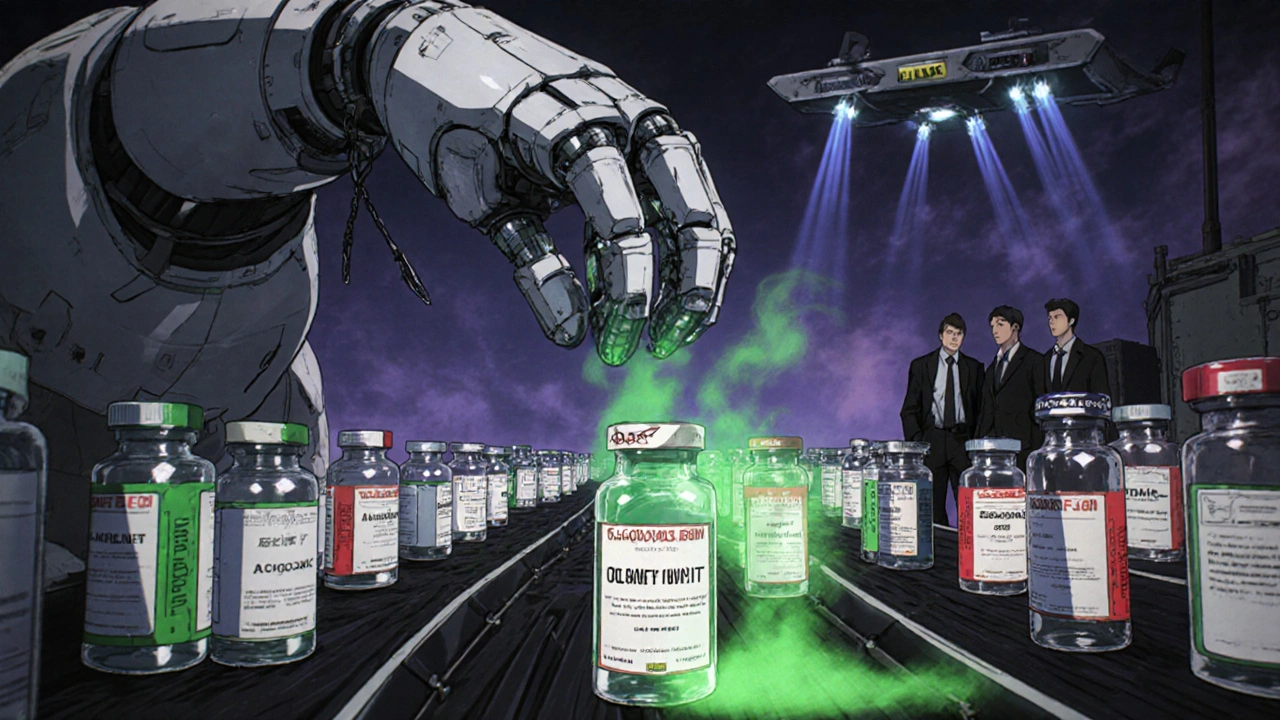When you take a pill, use an inhaler, or get an IV drip, you expect it to be safe. You don’t think about how it was made. But the U.S. Food and Drug Administration (FDA) spends every day checking exactly that - and they’re finding serious problems. In 2025, the FDA issued 32% more warning letters for manufacturing quality failures in medical devices compared to 2024. That’s not a small uptick. It’s a signal: manufacturing deficiencies are getting worse, not better.
Aseptic Processing Failures Are the #1 Problem
The most common issue the FDA finds? Broken aseptic processing. That means sterile environments weren’t kept sterile during production. In nearly half (47%) of all 2025 warning letters, inspectors saw this. Think of it like trying to bake a cake in a dusty kitchen while someone’s sweeping the floor. You’re not just risking bad taste - you’re risking infection. One company, Health and Natural Beauty USA Corp., got a warning letter in July 2025 because their media fill studies - tests that simulate sterile filling - were incomplete. They didn’t prove their machines could consistently fill vials without letting in germs. Another, Creative Essences, Inc., was cited in September 2025 for workers handling sterile products without proper gowning or airflow controls. These aren’t one-off mistakes. They’re systemic. And they lead to contaminated products that can kill people. The 2007-2009 heparin contamination crisis, which caused 84 deaths, still haunts the industry. The FDA hasn’t forgotten. Today, they’re watching even closer. If your facility doesn’t have validated, repeatable sterile procedures, you’re on their radar.Data Integrity: Fake Records, Real Danger
You can’t fix what you can’t measure. But if your data is fake, you’re flying blind. Data integrity failures showed up in 39% of 2025 warning letters. That’s almost two out of every five companies. The FDA isn’t just looking for missing entries. They’re checking audit trails. In one case, Guangxi Yulin Pharmaceutical Group Co. Ltd. had UV-Vis and IR instruments with no audit trails at all. That means no one could tell who changed a result, when, or why. Another company used laminated production records with erasable markers - so someone could literally wipe out a failed test and write in a passing one. The FDA’s ALCOA+ standards aren’t optional. Records must be:- Attributable
- Legible
- Contemporaneous
- Original
- Accurate
- And now: +Complete, Consistent, Enduring, Available
Material Control: Dirty Ingredients, Deadly Results
Bad ingredients make bad medicine. That’s simple. But 35% of warning letters in 2025 cited failures in material control. Companies didn’t test raw materials properly. Or worse - they trusted suppliers without checking. One major red flag: diethylene glycol (DEG) contamination. DEG is a toxic chemical sometimes found in cheap glycerin or sorbitol. It can cause kidney failure and death. The FDA requires testing at 0.1% sensitivity - meaning even tiny amounts must be caught. Health and Natural Beauty USA Corp. got hit for not doing this. They assumed their supplier tested it. They didn’t verify. The U.S. Pharmacopeia (USP) has clear standards - Chapter <1085> - that spell out how to test for these contaminants. Ignoring them isn’t negligence. It’s recklessness. And the FDA is now cross-checking supplier certificates with independent lab results. If your paperwork doesn’t match reality, you’re flagged.Process Validation: Making It Up as You Go
If you don’t know how your process works, you can’t control it. Yet 28% of warning letters in 2025 pointed to missing or flawed process validation. This means companies didn’t prove their methods consistently produce safe, effective products. One company made toothpaste without ever validating their mixing or filling steps. Another didn’t establish proper analytical methods to test potency. That’s like baking cookies without knowing if the oven’s hot enough - you’ll get burned. The FDA expects three consecutive successful validation batches. Each batch must meet strict in-process controls. No shortcuts. No “we’ve always done it this way.” The 2022 Process Validation Guidance isn’t a suggestion - it’s the rule. And they’re enforcing it.The Real Problem: Quality Culture
Here’s what no one talks about enough: most of these issues aren’t technical. They’re cultural. Dr. David Lim from Compliance Architects found that 78% of companies cited in 2025 warning letters had leadership that prioritized speed over safety. Production managers pushed through batches even when tests failed. Quality teams were ignored. Managers didn’t have the authority to stop the line. One company in China wrote in their response: “This site does not prepare batch production records for every batch.” That’s not a typo. That’s a belief system. And the FDA is now trained to spot it. In India, 24 warning letters in 2025 were tied to data integrity failures - not because their tech was bad, but because their culture tolerated it. In China, 28 letters were for analytical method validation issues - because validation was seen as a paperwork exercise, not a science. The FDA’s Quality Management Maturity (QMM) program, launched in 2024, is trying to fix this. So far, 87 companies have voluntarily joined. Those with strong quality cultures had 63% fewer repeat findings and fixed problems 41% faster. The message is clear: if you treat quality like a cost center, you’ll pay more later.What Happens When You Get Caught?
Getting a warning letter isn’t the end - but it’s the start of a long, expensive nightmare. The FDA requires 92% of companies to hire independent CGMP consultants. That’s not optional. You can’t fix your own system if you caused the problem. Remediation takes 6 to 18 months. And during that time, your products can’t enter the U.S. market. If you’re on Import Alert 66-40, your shipments get stopped at the border. Every single one. No exceptions. As of November 20, 2025, 147 facilities are on that list. That’s 147 companies losing millions. The FDA has also ramped up unannounced inspections - up 40% in 2025. And they’re now targeting U.S. facilities too. In 2026, they plan to do 1,200 unannounced inspections - up from 850 in 2025. You can’t hide.
Who’s Getting Hit the Most?
The numbers don’t lie. China, India, and Malaysia account for 73% of all 2025 warning letters.- China: 28 letters for failed analytical method validation. Too many companies skip method development and rely on old, unproven tests.
- India: 24 letters for data integrity. Weak oversight from CDSCO (India’s regulator) means many companies think they won’t get caught.
- Malaysia: 9 letters for poor quality unit authority. Quality teams are often underfunded and overruled by production.
What Should You Do If You’re in Manufacturing?
If you make drugs or medical devices, here’s what you need to do - now:- Test your materials like your life depends on it. Use USP <1085> for glycerin, sorbitol, and other high-risk inputs. Don’t trust supplier certificates.
- Lock down your data. Audit trails must be enabled, user-specific, and retained for 180+ days. No exceptions.
- Validate every process. Three consecutive batches. In-process controls. Acceptance criteria. No shortcuts.
- Fix your culture. Give your quality team real power. Reward people who stop production for safety. Punish those who cover up failures.
- Prepare for unannounced inspections. Your facility should be inspection-ready every day. Not just before the scheduled visit.
What’s Next?
The FDA isn’t slowing down. In 2026, they’ll start using QMM assessment results to decide inspection frequency. Companies with strong cultures get fewer visits. Those with poor cultures get more - and harder ones. New focus areas are emerging:- Cloud-based quality systems - 12 warning letters in 2025 cited weak controls
- Contract testing labs - 8 letters for lack of oversight
- Continuous manufacturing - 5 letters for incomplete validation
What are the most common FDA manufacturing deficiencies in 2025?
The top three are aseptic processing failures (47% of warning letters), data integrity issues (39%), and material control problems (35%). These include broken sterile environments, fake or missing audit trails, and untested raw materials like glycerin that may contain toxic contaminants.
What happens if the FDA finds a manufacturing deficiency?
You’ll receive a warning letter requiring a detailed corrective plan. You must hire an independent CGMP consultant, fix the issue within 6-18 months, and prove your changes work. If you don’t, your products can be blocked from entering the U.S. via Import Alert 66-40 - meaning every shipment gets stopped at the border.
Why is data integrity such a big deal for the FDA?
Because if you can’t trust your data, you can’t trust your product. Fake records hide failures. The FDA requires ALCOA+ compliance: records must be attributable, legible, contemporaneous, original, accurate, complete, consistent, enduring, and available. Systems without audit trails, user controls, or 180-day retention are automatically non-compliant.
Which countries are most affected by FDA manufacturing warnings in 2025?
China, India, and Malaysia account for 73% of 2025 warning letters. China leads in analytical method validation failures, India in data integrity issues, and Malaysia in weak quality unit authority. But the FDA targets culture, not geography - any facility with poor practices gets flagged.
Can a company recover after an FDA warning letter?
Yes - but it’s expensive and slow. Companies must fix the root cause, hire an independent consultant, validate all changes, and submit a detailed plan to the FDA. Those with strong quality cultures see 63% fewer repeat issues and fix problems 41% faster. Recovery is possible, but only if leadership truly changes how they value quality.





David Cunningham
November 22, 2025 AT 23:43Been in pharma QA for 15 years. Saw this coming. The real issue? Companies treat compliance like a box to check, not a culture to build. You can’t audit your way to safety.
Ravi Kumar Gupta
November 23, 2025 AT 01:26India gets slammed but nobody talks about how CDSCO is underfunded and overworked. We’re not trying to cheat - we’re trying to survive on $0.02 profit per pill. The FDA wants perfection but won’t pay for it.
Rahul Kanakarajan
November 24, 2025 AT 15:34Oh please. You think this is new? I worked at a plant in Pune where the QA head got fired for stopping a batch. The boss said ‘we’ll fix it after shipping.’ This isn’t negligence - it’s business as usual. The FDA’s just catching up.
Latonya Elarms-Radford
November 25, 2025 AT 20:12Let’s be brutally honest - this isn’t about sterile environments or audit trails. It’s about the collapse of the modern industrial ethos. We’ve outsourced not just labor, but moral responsibility. The FDA isn’t policing factories - it’s policing a civilization that forgot what ‘care’ means. When your entire supply chain is optimized for speed, not soul, you don’t get contamination - you get existential decay.
Miruna Alexandru
November 26, 2025 AT 12:49Interesting that the post cites 2025 data - which hasn’t happened yet. Either this is speculative fiction or the author is misleading. Also, ‘32% more warning letters’ doesn’t equal ‘worse quality’ - it could mean better detection. Correlation ≠ causation, and the entire argument is built on cherry-picked stats.
Mark Williams
November 26, 2025 AT 16:46Process validation isn’t optional - it’s the foundation of CGMP. If you can’t demonstrate control over your critical process parameters, you’re not manufacturing - you’re gambling. And the FDA’s new QMM framework is the only thing keeping this industry from total collapse.
luke young
November 27, 2025 AT 19:11Just want to say - I’ve seen both sides. I worked in a U.S. plant that got a warning letter too. We had the tech, the training, the budget… but leadership didn’t listen. It’s not about where you’re from. It’s about who’s in charge. Fix the culture, fix the problem.
steve o'connor
November 28, 2025 AT 09:03My cousin works in a lab in Dublin that supplies API to U.S. firms. They just upgraded their LIMS system with full audit trails and user roles. Took 18 months. Cost $2M. No one outside the industry knows this stuff happens. Hats off to the quiet heroes.
Daniel Jean-Baptiste
November 30, 2025 AT 06:29Just had a supplier send me a COA with a typo in the batch number… and I didn’t catch it till after we used it. Scary stuff. Maybe we all need to slow down a bit
Patrick Marsh
December 1, 2025 AT 15:19Unannounced inspections up 40%. That’s the only thing that works.
manish chaturvedi
December 2, 2025 AT 06:21As someone from India who has worked with U.S. regulators, I can say this: the problem isn’t that we cut corners - it’s that we’re not given the resources to do it right. We’re expected to meet U.S. standards on Indian wages. The FDA should help, not just punish. Quality is not a luxury - it’s a right. But rights need investment.
New Yorkers
December 2, 2025 AT 11:12They’re not just warning letters - they’re obituaries for companies that thought quality was a cost. The FDA is the last line of defense between your grandmother’s insulin and a vial of poison. If you think that’s dramatic, you’ve never held a parent’s hand while their child dies from a contaminated IV.